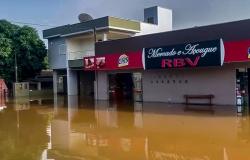Long periods of drought or seasons of intense rain cause strangeness among indigenous leaders in the five regions of the country. More than a surprise, climate change impacts production in the field and affects the quality of life of entire communities, according to chiefs who are present at Acampamento Terra Livre (ATL), in Brasília, this week. 
Heard by Brazil Agencyfive chiefs from different parts of Brazil lament the destruction and pollution of natural resources and also the pressure from non-indigenous people against their preserved sites.
Southeast region


Baiara Pataxó – Joédson Alves/Agência Brasil
Chief Baiara Pataxó, 64 years old, who lives in a community in the city of Açucena, Minas Gerais, testifies that, in the last decade, cassava, corn and bean plantations have stopped producing as much as before. The products are sold to traders in nearby cities and support the community of 80 people.
“Before, the rains started in September. In recent years, only in December. Of course, this is not normal”, says Baiara Pataxó.
In addition to climate change, the community in Minas Gerais was impacted by the environmental crime of January 25, 2019, when the dam at Mina Córrego do Feijão, owned by the mining company Vale, in Brumadinho, broke. In addition to causing the deaths of 272 people, the waste polluted the Doce and Corrente rivers in the region. “This whole thing has been terrible. We are currently working on restoring 45 thousand seedlings of native and fruit trees. Twenty indigenous people are working on this task”, he states.
North region


Dario Kopenawa – Joédson Alves/Agência Brasil
The relationship between climate change and other criminal actions is also witnessed by chief Dario Kopenawa Yanomami, 39, who lives in Roraima.
“We are living there with the invasion of miners and garimpeiros. We are a community of 32 thousand people suffering from climate change and, at the same time, from mercury contamination”, he laments.
The chief finds that the rains have changed and are “very different” from what they were when he was a teenager and when he was growing up in the region.
“We have asked our shamans for rain [guias religiosos]. But it is a fact that the taioba, cassava and banana fields are not what they used to be.”
Northeast Region


Chief Tchydjo Ue – Joédson Alves/Agência Brasil
Chief Tchydjo Ue, 76 years old, from the Fulni-ô people, lives in a village, in the city of Pacatuba, in Sergipe, where there are 86 families. He considers that today the scenario has been completely transformed compared to the time of his youth.
“We are close to the coast (96 kilometers), but it is much hotter than before. Younger people have felt the difficulty of working in the fields and ended up giving up”, says the chief.
Changes in climate combined with changes in behavior.
“Young people have also changed. They want to leave. They live on the internet and on their cell phones,” she says. To diversify activities, the indigenous leader says he has encouraged handicrafts, as corn, cassava and beans are not enough for subsistence. Another activity is knowledge of nature. “I am called to speak in Europe and the United States about indigenous knowledge, but they need to know more about us here.”
Midwest region


Tanoné Carirí Xocó – Joédson Alves/Agência Brasil
The destruction of the cerrado and climate changes were closely monitored by chief Tanoné, who is 70 years old and has lived in the Federal District since 1986. She remembers, with regret, that Brasília had cold seasons, which “disappeared”.
In the community where she lives, in the Noroeste Sector, there are 16 families. In the region, which grew with real estate expansion, she says she has worked to restore the scenario. There are 16 hectares of area in which corn, beans, Jatobá and cotton plantations illuminated the scene.
“Beans became rare. Cotton, too. It’s either a lack of rain or intense storms.” The chief asked government entities to plant ipe trees to return the place to new colors.
South region
In the city of José Boiteux, in Santa Catarina, a community of 2,300 people of the Xokleng ethnic group is worried about the approaching rainy season, which has become more intense in the last decade.


Setembrino Kokleng – Joedson Alves/Agência Brasil
According to chief Setembrino, 53 years old, from the same ethnic group, the main job now is to be aware of the floods and teach environmental preservation to the indigenous people in the classroom.
“It is right to pay attention to the Amazon, but we also need to remember the South. We are now working on planting pine trees. We have to look at now and then.”
“As it started to rain a lot more, the containment dam tends to reach its limit repeatedly. We no longer have a safe place to live”, says one of the leaders of the Xokleng ethnic community, Geomar Crendô.











